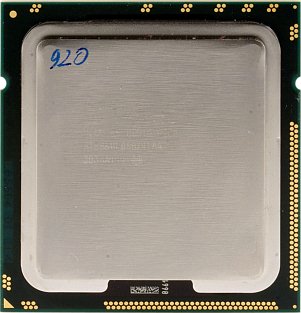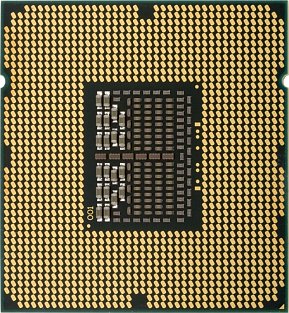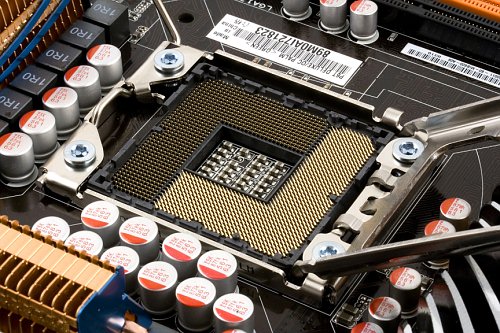Intel announced a new processor microarchitecture, a new CPU family, and a new socket for these processors in November, 2008. In this article we'll just mention that the company has announced only top Nehalem processors so far, with four physical cores and SMT technology (Simultaneous Multi-Threading -- in fact, it's well-known Hyper-Threading technology used in Pentium 4 processors), which provides eight virtual cores. This 45nm core is called Bloomfield. Along with the overhauled processor microarchitecture (changes in cache hierarchy, SMT, new processor instructions, etc), the announced models feature an integrated memory controller -- it's moved from the chipset closer to the main consumer. The earlier Bloomfield core has a three-channel memory controller, designed for DDR3-1066. Havendale and Lynnfield, expected in the second half of 2009, which are actually cheaper modifications of Nehalem (with integrated entry-level graphics core) will come with a dual-channel controller, which is currently used in modern chipsets.
 |
 |
Besides, Havendale and Lynnfield will be connected to the chipset via DMI (which is used in modern Intel chipsets to connect bridges). And Bloomfield uses for this purpose a new QPI bus, designed in Intel to connect processors (sockets) -- it's a functional counterpart of HyperTransport, which is widely used in AMD solutions. The new processors Core i7 and Core i7 Extreme Edition certainly require a new socket -- Socket 1366 (instead of Socket 775). Most new contacts in the socket are necessary to connect a processor with memory modules; besides, there have appeared more power/earth pins and some reserved pins (probably responsible for the second QPI channel required by server models based on Nehalem).

Support for all new processors certainly requires new chipsets (as the old ones were connected with a processor via FSB). This article will examine a top X58 Express chipset that starts the series of Intel 5x chipsets, which is designed for processors with the top Bloomfield core. As there are not so many fresh models of Core i7 and Core i7 Extreme Edition, and the new socket won't remain the only new solution for long, this decision looks quite logical: manufacturers have got an opportunity to make money on enthusiasts only now. And by the time Nehalem enters the mass segment of the market, Intel will launch more democratic chipsets (in prices and features). Motherboards with these chipsets will use the new socket, as those processors will have a dual-channel memory controller and a different bus to communicate with the chipset -- Socket 1156.
Intel X58 Express
Northbridge of the chipset cannot be called MCH anymore (Memory Controller Hub). Intel had to rename it to IOH (Input/Output Hub), although Southbridges from this company (ICH) bear the same name -- I/O Controller Hub. Anyway, we'll still call this chipset unit a Northbridge. Let's take a look at its key characteristics (so few of them left!):
- Support for new processors (represented by Core i7 and Core i7 Extreme Edition at the time this article was published), based on Nehalem, connected to QPI bus
- Two PCI Express 2.0 x16 graphics interfaces, each of which can be split into two half-speed graphics interfaces or even four interfaces (1/4 of the original speed)
- Additional PCI Express 2.0 x4 interface, which can be split into two half-speed interfaces
- DMI bus (~2 GB/s bandwidth) to the ICH10/R Southbridge
Note that the top chipset of the new series (that has traditionally rolled out the first) uses the old Southbridge, and the new SB will come out only with the appearance of Mid-End chipsets. However, there is presently no objective need in new peripheral interfaces (we only wish USB 3.0 to appear at least on the horizon), so ICH10/R is not a problem even for a top chipset. Let's sum up features of these Southbridges:
- Up to six PCIEx1 ports (PCI-E 1.1)
- Up to four PCI slots
- Six Serial ATA II ports for six SATA300 devices (SATA-II, the second generation of the standard), AHCI and NCQ (ICH10 supports this mode only in Windows Vista), hot plug, eSATA, and port splitters
- RAID (ICH10R only) 0, 1, 0+1 (10) and 5 with Matrix RAID function (the same array of drives can be used in several RAID modes -- for example, two drives may form RAID 0 and RAID 1, each array will use its own part of the disks)
- 12 x USB 2.0 devices (on two EHCI host controllers) supporting hot plug
- Gigabit Ethernet MAC controller and a special interface (LCI/GLCI) for a PHY controller (i82567 for Gigabit Ethernet, i82562 for Fast Ethernet)
- Intel Turbo Memory (only ICH10R)
- High Definition Audio (7.1)
- Binding for low-speed and outdated periphery, other things
Now let's talk about changes and new technologies in the chipset.
What concerns CPU support, it's all simple: the chipset has a QPI port, and any processors using this bus (modern Bloomfield core) will work in motherboards with Intel X58. However, maximum throughput of the QPI port may differ: 4.8 GT/s or 6.4 GT/s (billion transfers per second), which correspond to 9.6 GB/s or 12.8 GB/s in each direction simultaneously. The difference in bandwidth is determined by the type of a processor (Core i7 Extreme Edition offers higher bandwidth). Note that higher bandwidth is provided not by a higher clock rate (as it was the case with Quad-Pumped Bus FSB), but owing to an increased multiplier relative to the reference BCLK (133 MHz).
Graphics interface of the X58 can provide two independent PCI Express 2.0 x16 ports. This is its maximum capacity, which is not unique: the same functionality was provided by X38 and X48 as well as top chipsets from NVIDIA. However, it's the first chipset for Nehalem with these characteristics. What concerns Bloomfield, it's not just the first chipset, but probably the only one at all: Intel will launch Low-End products from the 5x series only to support Havendale and Lynnfield. NVIDIA also gave up the idea to design a chipset for Bloomfield (even though it has a license for QPI, so technically it's possible). But it promised to launch a new series for cheaper Nehalem processors.
NVIDIA's refusal resulted in long-awaited news: it's the first time when a third-party chipset gets a license to support SLI. But this license has a number of conditions: a license has to be obtained by a certain manufacturer for a certain motherboard model -- it's a special complex procedure that integrates ID info into BIOS. There is an alternative solution, recommended by NVIDIA -- nForce200 bridge (or even two). However, considering high prices for Socket 1366 motherboards, the number of solutions with nForce200 will be very low. As Intel chipsets still support CrossFireX configurations, Intel X58 has become an absolutely unique chipset -- the first to support both SLI and CrossFireX!
And now let's digress a little from specifications and take a look at the situation as a whole. Northbridge of the X58 chipset is actually one big PCI Express [2.0] controller for discrete graphics. Yep, it's also responsible for data arbitration from/for SB peripheral controllers (but it's just another chain link). Besides, it offers four PCI-E 2.0 lanes for periphery, just because it can do it. It would have been more logical to delegate the graphics interface to another chipset unit and shorten the CPU+chipset chain to two elements. (You may remember that NVIDIA often used chipsets consisting of a single chip.)
Why isn't it implemented here? For one, this is not strictly necessary: modern chipsets from AMD use two bridges with this very distribution of responsibilities, when a Northbridge is used only as a graphics bus controller. For two, apart from the necessity to overhaul ICH10 Southbridge to support a lot of PCI Express 2.0 lanes, we should keep in mind heat release: bridges responsible for two PCIEx16 ports are hot enough to pose problems for their integration.
That's how the current Intel solution looks like: X58, as a top chipset supporting 36 PCI-E 2.0 lanes, will include two chips with traditional architecture. But Mid-End platforms that will roll out in the second half of 2009 will be based on the single-chip P55 (and its cheaper modifications). PCI-E 2.0 controller (only for 16 lanes, actually, as a Mid-End solution) will be integrated not into Southbridge, but into future processors (for the new socket). These processors will be rid of the hot high-performance QPI bus -- it's currently used for data exchange with graphics cards, because throughput of a single PCIEx16 (2.0) port is 16 GB/s, not much lower than in QPI with Core i7 processors. What concerns full load on both graphics ports, even QPI bandwidth will be insufficient with Core i7 Extreme Edition. (On the other hand, there presently exist no solutions that can load two PCIEx16 (2.0) ports completely. It's not necessary, because such immense throughput is not mandatory for graphics cards.)
As future chipsets from Intel (at least Mid-End solutions) will in fact be slightly modified Southbridges (ICH11 is a better name here than P5x), processors will communicate with them via DMI. So we can say that Northbridge has moved to a CPU.
X58 releases less heat than previous top chipsets from Intel owing to the removed memory controller. But on the whole, the difference is not that significant (don't forget about QPI). We gathered information on the latest chipsets from Intel in a single table. But it does not give a simple answer: heat release is also affected by fabrication process (65nm since P45).
| Chipset (Northbridge) |
X58 IOH |
X48 MCH |
X38 MCH |
P45 MCH |
| Processor bus, bandwidth |
QPI, 25.6 GB/s |
FSB, 12.8 GB/s |
FSB, 10.7 GB/s |
FSB, 10.7 GB/s |
| Memory controller, maximum mode |
- |
2xDDR3-1600 |
2xDDR3-1333 |
2xDDR3-1333 |
| PCI Express 2.0 controller |
2xPCIEx16 + PCIEx4 |
2xPCIEx16 |
2xPCIEx16 |
PCIEx16 |
| TDP, W |
24.1 |
30.5 |
26.5 |
22 |
| Heat release (Idle), W |
8.5 |
15.1 |
12.3 |
9 |
Generally speaking, the most important conclusion for us is that X58 does not have special cooling requirements. This chipset is similar to P45 in this respect. But we have no doubts that motherboard manufacturers will try to compete in bulky bombastic cooling systems on their top products.
Conclusions
We cannot say that Intel X58 adds new useful features that make it expedient to upgrade to motherboards with this chipset. However, people will have to buy them, because other offers for Socket 1366 simply don't exist. Thus, if you are consumed with desire to assemble a computer with a top Nehalem processor (Bloomfield core), your choice is obvious. Now that you have read this article, you understand what basic features your new motherboard will have. We don't have any serious gripes with X58: it's a decent top chipset with a unique feature --official support for both SLI and CrossFireX. The only shortcoming of Socket 1366 solutions will be their inadequately high prices (despite democratic prices for lower Core i7 processors), but it's an attribute of top configurations. Mass-scale Nehalem systems will appear only in the second half of 2009.
Write a comment below. No registration needed!

